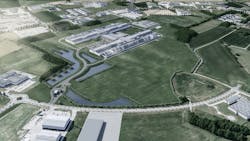Sponsored
With the growth of data-hungry industries like e-commerce, telecommunications, financial services, health care, and military applications, there has been a seemingly insatiable need for data centers.
According to Electrical Marketing’s construction project database, at least 30 data centers either broke ground or hit the planning stages over the past two years (see Table on page 22). Many of these facilities will be home to data from one of the FAANG companies — Facebook, Apple, Amazon, Netflix and Alphabet’s Google, or other tech behemoths such as IBM, Microsoft, Oracle and Alibaba. These projects are large, with the total estimated construction value of these projects ranging from $200 million up to $1 billion.
That trend shows no sign of stopping. Google made a big splash in mid-February by announcing plans for a $13-billion 2019 investment in data centers and offices across the United States, with major expansions in 14 states. Google CEO Sundar Pichai said in a blog post, “These new investments will give us the capacity to hire tens of thousands of employees and enable the creation of more than 10,000 new construction jobs in Nebraska, Nevada, Ohio, Texas, Oklahoma, South Carolina and Virginia. With this new investment, Google will now have a home in 24 total states, including data centers in 13 communities. The year 2019 marks the second year in a row we’ll be growing faster outside of the Bay Area than in it.
Google’s data center in Cedar Rapids is just one of several facilities in Iowa. The Cedar Rapids, IA-Omaha, NE area attracts data center operators because of a large underground fiber-optic network, low chance of seismic activity and central location.
“Our new data center investments, in particular, will enhance our ability to provide the fastest and most reliable services for all our users and customers. As part of our commitment to our 100% renewable energy purchasing, we’re also making significant renewable energy investments in the U.S. as we grow. Our data centers make a significant economic contribution to local communities, as do the associated $5 billion in energy investments that our energy purchasing supports.”
In addition to the new Google data centers in the states mentioned previously, several markets have emerged as hot spots for data center construction, including Chicago; the Omaha, Neb./Council Bluffs, Iowa, area; Goodyear, AZ; Prineville, OR; northern New Jersey (because of its proximity to New York City); and Loudoun County, Va., which is nicknamed “Data Center Alley” because of the massive concentration of these facilities 30-40 miles west of Washington, D.C.
According to the Loudoun County Department of Economic Development, the county is home to up to 70% of the world’s Internet traffic. There’s currently 13.5 million square feet of data centers operational in the county centered in the towns of Ashburn, Sterling, and Manassas — and another 4.5 million square feet under development. A report at www.datacenterfrontier.com said that Dominion Power, the local utility, already delivers a gigawatt of power to these data centers, and that Amazon Web Services “has gained approvals for more than 1 gigawatt of generator capacity to support its current and figure data center needs in the region.”
A wind farm will provide all the power for Facebook’s data center in Odense, Denmark.
Down the road, look for continued growth in the construction of data centers by the FAANG companies, and growth in the development of “edge computing” facilities, which, in contrast to the humongous “hyperscale” data centers built by these and other tech companies, are smaller data centers built closer to customers’ facilities. A post at www.info.siteselectiongroup.com said, “Hyperscale data centers will increase in needed megawatts of power in single campuses totaling hundreds of thousands of square feet of raised-floor environment. Yet on a much smaller capacity level — but just as critical — edge data centers need to meet the challenges of delivering an enhanced user-experience with low latency. These edge facilities can have dense power needs with many being sized less than a few hundred square feet.
“The projections for FAANG demand for 2019 will be ‘more of the same’ and should easily double 2018’s record total. The average size is expected to increase to the point that a 100 MW contract should not be a surprise.”
In addition to the companies and industries mentioned earlier in this article, industry observers believe the development of data-intensive 5G wireless networks over the next few years will be an additional area of growth for data centers. Because the electrical, network cabling, and backup power systems are such core components of both the massive hyperscale data centers and smaller data centers servicing edge computing facilities, the data center market segment would appear to one of the better market opportunities over the next few years for distributors, contractors, electrical engineers, and other electrical construction professionals.




